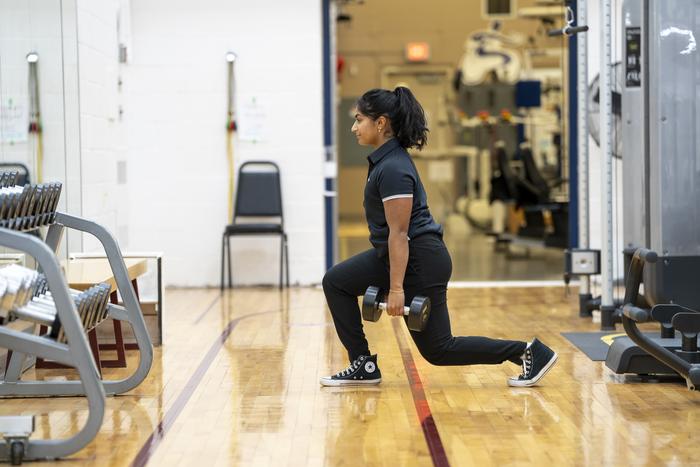
Recent scientific research from McMaster University in Hamilton, Ontario, has shed new light on the long-held belief regarding the synchronization of resistance training with menstrual cycle phases. The notion that the timing of workouts during specific hormonal phases could enhance muscle growth and strength has been a popular topic of conversation among fitness enthusiasts, fueled by countless articles and social media influencers advocating for an approach commonly referred to as ‘cycle syncing’. However, new findings suggest that these beliefs might not hold water when scrutinized through the lens of scientific inquiry.
The research, conducted by a team of kinesiologists, specifically set out to investigate the relationship between different phases of the menstrual cycle and muscle protein synthesis, a critical process in muscle development. Contrary to many claims circulating in fitness circles, the study revealed that exercising at various stages of the menstrual cycle did not result in any significant effects on the synthesis of new muscle proteins. This is vital information for women who pursue strength training, as it provides evidence that they need not schedule their workouts around their menstrual cycles to optimize muscle development.
Many proponents of cycle syncing argue that fluctuations in hormone levels throughout the menstrual cycle can affect a woman’s ability to build muscle. They often reference various studies on animal models to support their claims. However, the findings of the McMaster study are groundbreaking in that they highlight the lack of substantial evidence in human subjects linking hormonal changes to muscle protein synthesis. Researchers found that regardless of whether participants exercised during the follicular phase—characterized by high estrogen levels—or the luteal phase, when progesterone levels peak, there were no differences observed in muscle protein production.
The implications of these findings are significant for women engaging in resistance training. Women often experience pressure to conform to specific training regimens based on these hormonal cycles, which can potentially lead to unnecessary restrictions surrounding their training schedules. With the knowledge that no physiological difference exists in response to resistance exercise in relation to the menstrual cycle, women are encouraged to train as they feel best, independent of hormonal considerations. This perspective opens up a range of possibilities for female athletes, allowing them to prioritize their training based on personal preference, energy levels, and recovery rather than be beholden to a cyclical schedule.
To reach these conclusions, researchers monitored the menstrual cycles of a cohort of healthy young women over a three-month period, verifying the regularity of their cycles before commencing the experimental phase. It became clear during the study that a typical 28-day cycle—often touted as the standard—only applies to a small fraction of women. Approximately 12 percent of women exhibit this ‘textbook’ cycle, while the remainder experience varied lengths and irregular patterns, which further complicates any attempts to synchronize physical training programs with menstrual cycles.
During the study, participants ingested a tracer molecule intended to help track and monitor muscle protein levels. After this initial phase, they engaged in heavy resistance training while researchers monitored muscle responses, striving to provide empirical data on the subject. The methods employed in this investigation were rigorous and designed to yield insights into the physiological responses of women during resistance exercises.
As the research content was finalized, the authors pointed out a need for further exploration into women’s health concerning physical activity and hormonal interplay. Suggestions included studies that explore how various training regimens relate to menstrual cycles and how different contraceptives, both oral and non-oral, might alter a woman’s physiological response to exercise. Such investigations could provide even more substantial clarity and contribute valuable knowledge to the field of exercise science.
Moreover, the prevailing culture surrounding fitness has been influenced heavily by social media, where influencers and celebrities can shape opinions and promote their personal training philosophies. This phenomenon contributes to widespread misconceptions regarding women’s health and fitness routines, often leading individuals astray from the fundamental principles of exercise science. A more scientific understanding, as evidenced by the McMaster study, can help demystify these myths and provide a clearer path for women looking to enhance their strength and wellbeing through resistance training.
In reassessing the impact of hormonal cycles on performance and recovery, it becomes evident that a greater emphasis needs to be placed on individualized training plans. Physical training should prioritize the unique experiences and preferences of each athlete, moving away from generalized advice that fails to consider the diversity of women’s physiological responses. Ultimately, the findings of this study can be empowering, allowing women to regain ownership of their fitness choices without the constraint of arbitrary cycle syncing philosophies.
As we strive for a nuanced understanding of women’s health in relation to fitness, these groundbreaking findings from McMaster University serve as a foundational piece of research, urging both scientists and fitness enthusiasts to reevaluate the relationship between menstrual cycles and exercise. The consensus among researchers is clear: women should feel confident engaging in their strength training irrespective of their hormonal state, aligning workouts with personal goals and physical sensations rather than outdated myths.
In conclusion, the discourse surrounding women’s systemic training regimens deserves a transformation based on empirical evidence and scientific inquiry. With new research continually revealed, women now have the opportunity to lift weights and pursue fitness during any phase of their menstrual cycle without concern, elevating their training experience towards broader fitness goals and holistic health.
Subject of Research: People
Article Title: Menstrual cycle phase does not influence muscle protein synthesis or whole-body myofibrillar proteolysis in response to resistance exercise
News Publication Date: March 3, 2023
Web References: https://pubmed.ncbi.nlm.nih.gov/39630025/
References: N/A
Image Credits: Credit: McMaster University
Keywords: Physical exercise, Skeletal muscle, Menstruation, Human health
Tags: cycle syncing debunkedfitness myths about womenhormonal effects on workoutsMcMaster University kinesiology researchmenstrual cycle and exercisemuscle protein synthesis researchoptimizing muscle gains for womenresistance training for womenscientific study on exercise and hormonesstrength training without cycle syncingwomen’s fitness and menstrual phaseswomen’s strength training





